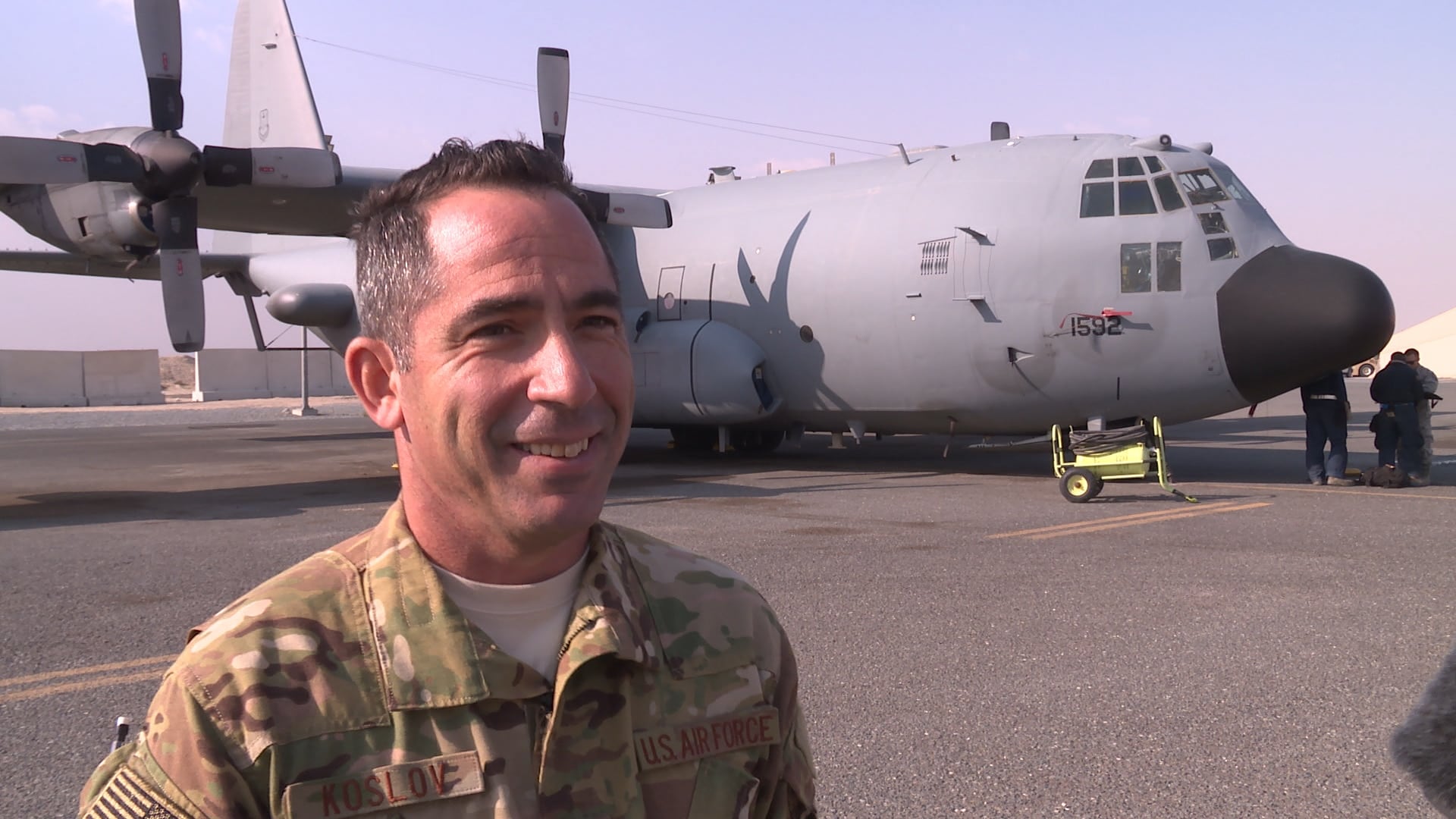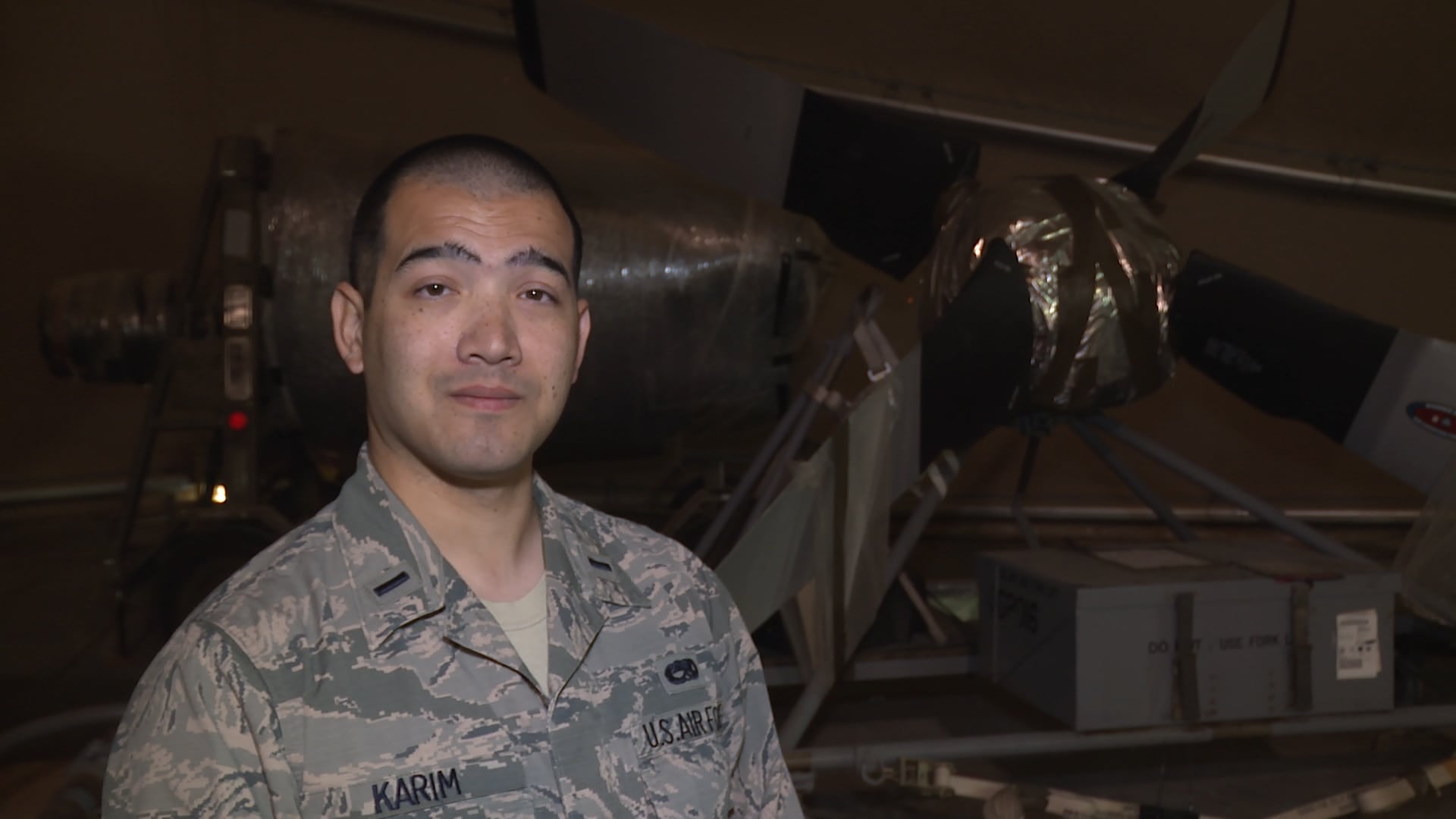UNDISCLOSED LOCATION, Southwest Asia — The Vietnam War-era airplane sitting on the flightline at the 386th Air Expeditionary Wing’s home base here may not look like much, but it is packed to the gills with electronics dedicated to sowing chaos in the ranks of the Islamic State terror group.
The EC-130H Compass Call is the Air Force’s main electronic attack weapon, said Lt. Col. Josh Koslov, commander of the 43rd Expeditionary Electronic Combat Squadron, in a Jan. 10 interview. The modified C-130 Hercules uses its broad array of systems to jam enemy communications and radar, leaving ISIS leaders and fighters blind and deaf, and with no idea what one another are doing.
"The bottom line is, if you can’t talk, you can’t fight," Koslov said. "It’s that simple. Our job is to create massive confusion in the Daesh [a pejorative Arabic nickname for ISIS] network. We are attacking their ability to command and control their forces and preventing them from executing against our Iraqi allies as they support the freedom of their country."
But keeping electronic warfare tactics up to date to stay ahead of the enemy is a constant struggle, he said.
"From the very beginning, electronic warfare has been a game of cat and mouse," Koslov said. "The adversary is going to adapt and move on to a new technology, and it's our job to find them and fix them … and be able to destroy them. Daesh is a very clever enemy. We are just a little bit better."
'A new threat'
One new tactic adopted by the Islamic State has been the use of off-the-shelf technology such as commercially available drones — including arming them with explosives.
Koslov would not discuss whether the EC-130H has been used to counter them, aside from saying, "If it radiates, they'll use it."

Lt. Col. Josh Koslov, commander of the 43rd Expeditionary Electronic Combat Squadron, said the Air Force's EC-130H Compass Call is the service's main electronic attack weapon, and it's being used to confuse, thwart and frustrate Islamic State fighters on the ground.
Photo Credit: Lars Schwetje/Staff
But the booby-trapped ISIS drones are a growing concern for U.S. troops.
Capt. Clayton Schmitt, a security forces officer deployed to Combined Joint Task Force-Operation Inherent Resolve, said Jan. 12 that ISIS' use of small drones such as quadcopters and fixed-wing remote-controlled airplanes is one of the newest and most unique tactics the task force has had to respond to in this war.
"This is a new threat," Schmitt said. "We are used to [indirect fire]. We are used to someone dropping a rocket or a mortar on us. We are used to someone setting up an IED on the roadside. We have plenty of good [tactics, techniques and procedures] in place to cover that sort of thing."
This is a different kind of menace, he said.
"This is an evolving threat. We have had to come up with … new [tactics to address] how are you going to react to someone bringing a little five-pound drone over your installation, having it hang out and surveil you or attempt to attack you?" he said.
While Schmitt would not discuss how the military deals with ISIS drones, he said the methods include electronic warfare to jam the drones and try to bring them down.
"The Air Force plays a big role in this, to use other systems like airborne systems to combat UASs," Schmitt said. "The Army, the Air Force, and several other services as well as coalition partners are all working on implementing systems that use electromagnetic jamming and electromagnetic frequency effects to counter UASs. We have seen a lot of success with those programs. We are going to continue using them and expanding on them."
When asked if the military is trying to make jammed ISIS drones seize up in midair and crash, or hijacking their controls to safely capture them and study them, Schmitt said, "Different systems come with different effects. All of those are options."
And the military is again using camouflage netting, like it did during World War II, to protect against drones trying to fly overhead and spy on their aircraft.
"We are used to people just trying to look at us with binoculars," Schmitt said. "We are not used to somebody flying their own airplanes over us and surveilling us with a video camera."
Troops also use small-arms fire to shoot drones out of the sky, Schmitt said.
"It is totally within the rules of engagement to go ahead and shoot that down," Schmitt said. "We have seen friendly forces do a lot of that. It has been relatively successful. Yet, of course, it is determined entirely on how close to a threat you are. If you are forward in a fight, it is a great option. If you are back at a hard location, where you are out of the fight, then maybe you have to be a little bit more concerned about where those bullets might be landing."
In need of some love
As for the EC-130Hs, there are four from the 55th Electronic Combat Group, out of Davis-Monthan Air Force Base in Arizona, deployed to the U.S. Central Command area of responsibility — an area stretching from Egypt to Kazakhstan.
Koslov would not say how many the 386th has, but said the wing's Compass Calls fly daily. One of the wing's EC-130Hs dates back to 1973, he said, and another was built in 1964, before the airframes were converted to become electronic attack aircraft.
"The aircraft is old and does require some love from our maintenance guys very often," Koslov said.
Providing that love can sometimes be tricky, said 1st Lt. John Karim, the aircraft maintenance unit officer in charge for the 43rd, who oversees 34 maintainers who work around the clock to keep the EC-130Hs in the air.
"This is a pretty old airframe," Karim said. "They break more often than not. … And these are breaks that have to be fixed before we can launch the aircraft safely again. ... Doing that in a quick, timely manner — that fixes it right the first time — is one of the challenges in our job."

First Lt. John Karim, the aircraft maintenance unit officer in charge for the 43rd Expeditionary Electronic Combat Squadron, oversees 34 maintainers who work around the clock to keep the EC-130H in fighting shape.
Photo Credit: Lars Schwetje/Staff
The four- or five-decade-old airframes need to be inspected regularly for structural weaknesses, Karim said. The wiring is old, as are the engines.
Trying to make the newer electronic warfare technology work with the older airframes can sometimes present challenges, he said. As a result, Compass Call maintainers need to know the ins and outs of every single piece of technology they're installing or repairing.
The airframe "was never really designed to do what we're doing with it," Karim said. "Sometimes we're finding problems, and then we're having to figure out how to fix those problems, whereas on another airframe, that'd all be right there in the tech data. It's more than just, 'this is a box, and I'm going to change the box.' It's, 'where is the wiring? Do I understand how the cards are actually working inside the box?' It takes a lot of brain cells."
A constant struggle
The Air Force in recent years has struggled to field enough experienced maintainers, particularly with a skill level of seven, stretching many flightlines thin. Karim said his maintainers are no exception.
"Maintenance needs that seven-level technician working on the line," Karim said. "And the way the Air Force is set up right now, either they're going to get promoted out of that tech sergeant rank up to the master sergeant rank, where they're no longer allowed to work on the line, or they're going to get out of the Air Force. That's just the way the Air Force is set up for maintenance right now."
While the Air Force is trying to hold on to more experienced maintainers through retention bonuses and other incentives, Karim said that so far he hasn't seen that effort yield results on the ground. Because his maintainers are short-staffed, he said, it takes them 12 hours to change a propeller blade — a job that would take a fully staffed crew eight hours.
"I can't do anything without good people," Karim said. "When it comes to doing that heavy, hard maintenance work, I need seven-level technicians that are experienced. I need that guy who's been working maintenance for a decade. He knows the air frame, he knows the systems. That's hard to replace."
But the maintainers also find time for humor in their jobs. For example, maintainers often use a black sticker to mark which propeller blade should be pointed down after the EC-130H lands, to keep oil from leaking out as the prop cools. Sometimes, those stickers are inside jokes — a Miller Lite logo, or the "Heisenberg" caricature of the villainous Walter White character from the show "Breaking Bad."
Compass Call planes have been continuously deployed to support CENTCOM since 2004, but have also served in every major U.S. contingency operation since it was created in 1983, including Kosovo, Haiti, Panama, Libya, Iraq, Serbia and Afghanistan.
Each Compass Call has a combat crew of 10 to 16 airmen, Koslov said. Aside from the typical four-airman crew that flies and navigates the plane, it also includes electronic warfare operators, cryptologic language analysts, special signal operators and airborne maintenance personnel.
Koslov, whose call sign is Mule, said the electronic warfare officer — also known as the mission crew commander — is responsible for prioritizing and executing all the jamming the plane does. For the ISIS fight, that means working with commanders of ground forces to figure out what kind of jamming effect is needed for a particular operation, and to jam their communications at precisely the right time and place.
Koslov wouldn't discuss what kind of communications the plane can jam or how it works, to avoid giving ISIS any clues about how to counter them.
Another on-board weapon the Air Force has are the cryptologic linguists.
"Their weapon is language," Koslov said. "When you're jamming communications, being able to discern and prioritize language is incredibly important. Their ability to tell me — from the strategic down to the tactical level — what Daesh is doing allows me, as an electronic warfare officer, and allows my crews to prioritize their effects in support of operations in support of Iraqi allies in order to defeat and destroy Daesh."
Stephen Losey is the air warfare reporter for Defense News. He previously covered leadership and personnel issues at Air Force Times, and the Pentagon, special operations and air warfare at Military.com. He has traveled to the Middle East to cover U.S. Air Force operations.




